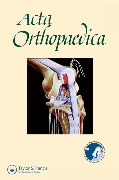
MIS not better than conventional technique for unicompartmental knee arthroplasty .
This report has been verified
by one or more authors of the
original publication.
Minimally invasive surgery did not improve outcome compared to conventional surgery following unicompartmental knee arthroplasty using local infiltration analgesia: a randomized controlled trial with 40 patients
Acta Orthop. 2012 Dec;83(6):634-41. doi: 10.3109/17453674.2012.736169. Epub 2012 Oct 840 patients undergoing unicompartmental knee arthroplasty with local anaesthetic infiltration were randomized to receive a minimally invasive or conventional surgical procedure to determine if minimally invasive surgery (MIS) would result in earlier postoperative home-readiness, as well as improved pain and functional outcomes. Follow-up was conducted over 6 months postoperatively. The results indicated that there were no benefits to using MIS techniques over conventional techniques as there were no differences in the outcomes.
Unlock the Full ACE Report
You have access to 4 more FREE articles this month.
Click below to unlock and view this ACE Reports
Unlock Now
Critical appraisals of the latest, high-impact randomized controlled trials and systematic reviews in orthopaedics
Access to OrthoEvidence podcast content, including collaborations with the Journal of Bone and Joint Surgery, interviews with internationally recognized surgeons, and roundtable discussions on orthopaedic news and topics
Subscription to The Pulse, a twice-weekly evidence-based newsletter designed to help you make better clinical decisions
Exclusive access to original content articles, including in-house systematic reviews, and articles on health research methods and hot orthopaedic topics

































































